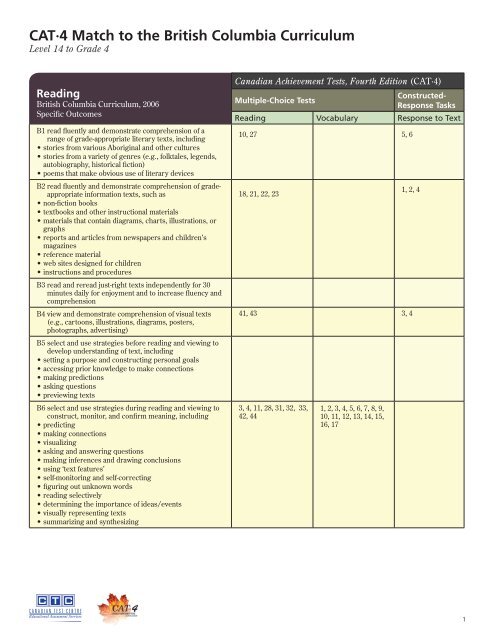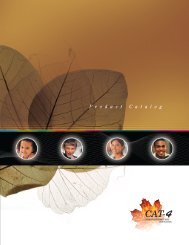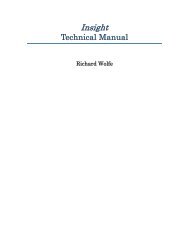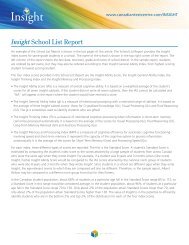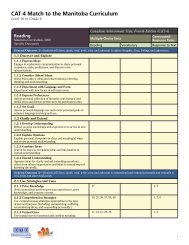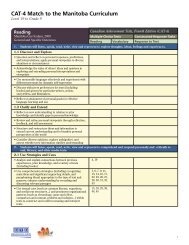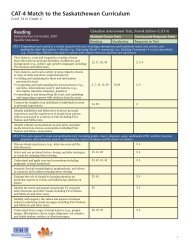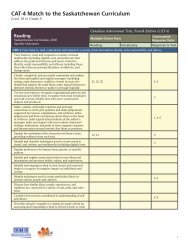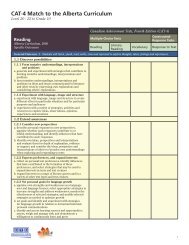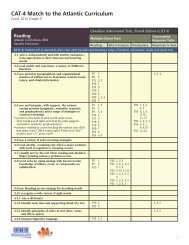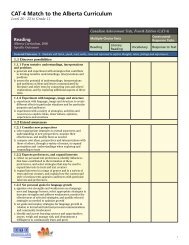Grade 4 - Canadian Test Centre
Grade 4 - Canadian Test Centre
Grade 4 - Canadian Test Centre
Create successful ePaper yourself
Turn your PDF publications into a flip-book with our unique Google optimized e-Paper software.
CAT∙4 Match to the British Columbia Curriculum<br />
Level 14 to <strong>Grade</strong> 4<br />
Reading<br />
British Columbia Curriculum, 2006<br />
Specific Outcomes<br />
B1 read fluently and demonstrate comprehension of a<br />
range of grade-appropriate literary texts, including<br />
• stories from various Aboriginal and other cultures<br />
• stories from a variety of genres (e.g., folktales, legends,<br />
autobiography, historical fiction)<br />
• poems that make obvious use of literary devices<br />
B2 read fluently and demonstrate comprehension of gradeappropriate<br />
information texts, such as<br />
• non-fiction books<br />
• textbooks and other instructional materials<br />
• materials that contain diagrams, charts, illustrations, or<br />
graphs<br />
• reports and articles from newspapers and children’s<br />
magazines<br />
• reference material<br />
• web sites designed for children<br />
• instructions and procedures<br />
B3 read and reread just-right texts independently for 30<br />
minutes daily for enjoyment and to increase fluency and<br />
comprehension<br />
B4 view and demonstrate comprehension of visual texts<br />
(e.g., cartoons, illustrations, diagrams, posters,<br />
photographs, advertising)<br />
B5 select and use strategies before reading and viewing to<br />
develop understanding of text, including<br />
• setting a purpose and constructing personal goals<br />
• accessing prior knowledge to make connections<br />
• making predictions<br />
• asking questions<br />
• previewing texts<br />
B6 select and use strategies during reading and viewing to<br />
construct, monitor, and confirm meaning, including<br />
• predicting<br />
• making connections<br />
• visualizing<br />
• asking and answering questions<br />
• making inferences and drawing conclusions<br />
• using ‘text features’<br />
• self-monitoring and self-correcting<br />
• figuring out unknown words<br />
• reading selectively<br />
• determining the importance of ideas/events<br />
• visually representing texts<br />
• summarizing and synthesizing<br />
<strong>Canadian</strong> Achievement <strong>Test</strong>s, Fourth Edition (CAT·4)<br />
Multiple-Choice <strong>Test</strong>s<br />
Constructed-<br />
Response Tasks<br />
Reading Vocabulary Response to Text<br />
10, 27 5, 6<br />
18, 21, 22, 23<br />
1, 2, 4<br />
41, 43 3, 4<br />
3, 4, 11, 28, 31, 32, 33,<br />
42, 44<br />
1, 2, 3, 4, 5, 6, 7, 8, 9,<br />
10, 11, 12, 13, 14, 15,<br />
16, 17<br />
1
CAT∙4 Match to the British Columbia Curriculum<br />
Level 14 to <strong>Grade</strong> 4<br />
Reading<br />
British Columbia Curriculum, 2006<br />
Specific Outcomes<br />
B7 select and use strategies after reading and viewing to<br />
confirm and extend meaning, including<br />
• self-monitoring and self-correcting<br />
• generating and responding to questions<br />
• making inferences and drawing conclusions<br />
• reflecting and responding<br />
• visualizing<br />
• using ‘text features’ to locate information<br />
• using graphic organizers to record information<br />
• summarizing and synthesizing<br />
B8 respond to selections they read or view, by<br />
• expressing an opinion with supporting evidence<br />
• explaining connections (text-to-self, text-to-text, text-toworld)<br />
• discussing and giving reasons for their choice of favourite<br />
texts<br />
B9 read and view to improve and extend thinking, by<br />
• predicting and explaining<br />
• visualizing<br />
• distinguishing between fact and opinion<br />
• analysing texts to consider alternatives<br />
• drawing conclusions<br />
• recognizing alternative viewpoints<br />
• summarizing and synthesizing<br />
B10 reflect on and assess their reading and viewing, by<br />
• referring to class-generated criteria<br />
• setting goals and creating a plan for improvement<br />
• taking steps toward achieving goals<br />
B11 explain how structures and features of text work to<br />
develop meaning, including<br />
• form, function, and genre of text (e.g., brochure about<br />
smoking to inform students; genre is persuasive)<br />
• ‘text features’ (e.g., copyright, table of contents, headings,<br />
index, glossary, diagrams, sidebars)<br />
• literary elements (e.g., character, setting, problem, plot,<br />
climax, conflict, theme, conclusion)<br />
• non-fiction elements (e.g., topic sentence, development of<br />
ideas with supporting details, central idea)<br />
• literary devices (e.g., imagery, sensory detail, simile,<br />
metaphor)<br />
• idiomatic expressions<br />
<strong>Canadian</strong> Achievement <strong>Test</strong>s, Fourth Edition (CAT·4)<br />
Multiple-Choice <strong>Test</strong>s<br />
Constructed-<br />
Response Tasks<br />
Reading Vocabulary Response to Text<br />
1, 2, 5, 8, 12, 14, 19, 20,<br />
29, 34, 35, 36, 37, 39,<br />
45, 46, 48<br />
15 3, 6<br />
16, 17, 25, 38 18, 19, 20, 21, 22, 23<br />
24, 25, 26, 27, 28, 29,<br />
30, 31, 32, 33, 34, 35,<br />
36, 37, 38, 39, 40<br />
6, 7, 9, 13, 24, 26, 30,<br />
40, 47<br />
1, 2, 3, 4, 5, 6<br />
2, 4, 5, 6<br />
1, 2, 5, 6<br />
2
CAT∙4 Match to the British Columbia Curriculum<br />
Level 14 to <strong>Grade</strong> 4<br />
Writing<br />
British Columbia Curriculum, 2006<br />
Specific Outcomes<br />
C1 write clear, focussed personal writing for a range of<br />
purposes and audiences that demonstrates connections<br />
to personal experiences, ideas, and opinions, featuring<br />
• clearly developed ideas using effective supporting details<br />
and explanations<br />
• sentence fluency through a variety of sentence lengths<br />
and patterns, with some emerging fluidity<br />
• experimentation with word choice by using new, different,<br />
more precise and powerful words<br />
• an authentic voice demonstrating a developing writing<br />
style<br />
• an organization that is meaningful, logical, and effective,<br />
and showcases a central idea or theme<br />
C2 write a variety of clear informational writing for a range<br />
of purposes and audiences, featuring<br />
• clearly developed ideas by using clear, focussed, useful,<br />
and interesting details and explanations<br />
• sentence fluency through a variety of sentence lengths<br />
and patterns, with some emerging fluidity<br />
• word choice by using some new and precise words<br />
including content-specific vocabulary<br />
• a voice demonstrating an appreciation of, interest in, and<br />
knowledge of the topic<br />
• an organization that includes an introduction that states<br />
the purpose, with easy to follow and logically sequenced<br />
details, and an ending that makes sense<br />
C3 write a variety of imaginative writing modelled from<br />
literature, featuring<br />
• well-developed ideas through the use of supporting<br />
details, especially interesting sensory detail<br />
• sentence fluency through a variety of sentence lengths<br />
and patterns, with some emerging fluidity<br />
• effective word choice by experimenting with new, more<br />
powerful and varied words, especially descriptive words<br />
• a voice demonstrating some sense of individuality<br />
• an organization that develops smoothly with a logical<br />
sequence, beginning with an engaging opening through<br />
to a satisfying ending<br />
C4 create meaningful visual representations that<br />
communicate personal response, information, and ideas<br />
relevant to the topic, featuring<br />
• development of ideas through clear, focussed, and useful<br />
details<br />
• connections to personal feelings, experiences, opinions,<br />
and information<br />
• an expressive voice<br />
• an organization in which key ideas are evident<br />
<strong>Canadian</strong> Achievement <strong>Test</strong>s, Fourth Edition (CAT·4)<br />
Multiple-Choice <strong>Test</strong>s<br />
Writing<br />
Conventions<br />
Spelling<br />
Constructed-Response Tasks<br />
Response to Text<br />
1, 2, 4<br />
3<br />
5<br />
3
CAT∙4 Match to the British Columbia Curriculum<br />
Level 14 to <strong>Grade</strong> 4<br />
Writing<br />
British Columbia Curriculum, 2006<br />
Specific Outcomes<br />
C5 select and use strategies before writing and<br />
representing, including<br />
• setting a purpose<br />
• identifying an audience<br />
• selecting a genre and form from samples provided<br />
• developing class-generated criteria based on analysis of<br />
the form of writing or representing<br />
• generating, selecting, developing, and organizing<br />
ideas from personal interest, prompts, models of good<br />
literature, and/or graphics<br />
C6 select and use strategies during writing and representing<br />
to express and refine thoughts, including<br />
• referring to class-generated criteria<br />
• examining models of literature<br />
• combining multiple sources of information<br />
• consulting reference material<br />
• considering and applying feedback from conferences<br />
to revise ideas, organization, voice, word choice, and<br />
sentence fluency<br />
• ongoing revising and editing<br />
C7 select and use strategies after writing and representing<br />
to improve their work, including<br />
• checking their work against established criteria<br />
• reading aloud and listening for fluency<br />
• revising to enhance writing traits (e.g., ideas, sentence<br />
fluency, word choice, voice, organization)<br />
• editing for conventions (e.g., grammar and usage,<br />
capitalization, punctuation, spelling)<br />
C8 use writing and representing to express personal<br />
responses and relevant opinions in response to<br />
experiences and texts<br />
C9 use writing and representing to extend thinking, by<br />
• developing explanations<br />
• expressing alternative viewpoints<br />
• creating new understandings<br />
C10 reflect on and assess their writing and representing, by<br />
• referring to class-generated criteria<br />
• setting goals and creating a plan for improvement<br />
• taking steps toward achieving goals<br />
<strong>Canadian</strong> Achievement <strong>Test</strong>s, Fourth Edition (CAT·4)<br />
Multiple-Choice <strong>Test</strong>s<br />
Writing<br />
Conventions<br />
26, 27, 28, 37,<br />
38, 39, 40<br />
29, 30, 31, 32,<br />
33, 34, 35, 36<br />
Spelling<br />
Constructed-Response Tasks<br />
Response to Text<br />
1, 2, 3, 4, 5<br />
1, 2, 3, 4, 5<br />
5<br />
1, 2, 3, 4<br />
4
CAT∙4 Match to the British Columbia Curriculum<br />
Level 14 to <strong>Grade</strong> 4<br />
Writing<br />
British Columbia Curriculum, 2006<br />
Specific Outcomes<br />
C11 use the features and conventions of language to express<br />
meaning in their writing and representing, including<br />
• complete simple and compound sentences<br />
• paragraphs to show the beginning of new ideas<br />
• correct noun-pronoun agreement<br />
• past, present, and future tenses<br />
• capitalization to designate organizations and to indicate<br />
beginning of quotations<br />
• commas after introductory words in sentences and when<br />
citing addresses<br />
• capitalization and punctuation (e.g., commas, apostrophes,<br />
begin to use quotation marks and commas in dialogue)<br />
• spelling multi-syllable words by applying phonic<br />
knowledge and skills and visual memory<br />
• conventional <strong>Canadian</strong> spelling for familiar and frequently<br />
used words<br />
• spelling unfamiliar words by applying strategies (e.g.,<br />
phonic knowledge, use of common spelling patterns,<br />
dictionaries, word walls, thesaurus)<br />
• legible writing that demonstrates awareness of alignment,<br />
shape, and slant<br />
• spacing words and sentences consistently on a line and<br />
page<br />
<strong>Canadian</strong> Achievement <strong>Test</strong>s, Fourth Edition (CAT·4)<br />
Multiple-Choice <strong>Test</strong>s<br />
Writing<br />
Conventions<br />
1, 2, 3, 4, 5, 6,<br />
7, 8, 9, 10, 11,<br />
12, 13, 14, 15,<br />
16, 17, 18, 19,<br />
20, 21, 22, 23,<br />
24, 25<br />
Spelling<br />
1, 2, 3, 4, 5, 6,<br />
7, 8, 9, 10, 11,<br />
12, 13, 14, 15,<br />
16, 17, 18, 19,<br />
20, 21, 22, 23,<br />
24, 25, 26, 27,<br />
28, 29, 30<br />
Constructed-Response Tasks<br />
Response to Text<br />
1, 2, 3, 4, 5<br />
5
CAT∙4 Match to the British Columbia Curriculum<br />
Level 14 to <strong>Grade</strong> 4<br />
Mathematics<br />
British Columbia<br />
Curriculum, 2009<br />
Specific Expectations<br />
Number<br />
<strong>Canadian</strong> Achievement <strong>Test</strong>s, Fourth Edition (CAT·4)<br />
Multiple-Choice <strong>Test</strong>s<br />
Mathematics<br />
Computation<br />
and Estimation<br />
Constructed-Response Tasks<br />
Math Processes<br />
A1 represent and describe whole numbers to 10 000,<br />
pictorially and symbolically<br />
A2 compare and order numbers to 10 000 51<br />
A3 demonstrate an understanding of addition of numbers<br />
with answers to 10 000 and their corresponding<br />
subtractions (limited to 3 and 4-digit numerals) by using<br />
personal strategies for adding and subtracting estimating<br />
sums and differences solving problems involving<br />
addition and subtraction<br />
A4 explain the properties of 0 and 1 for multiplication, and<br />
the property of 1 for division [C, CN, R]<br />
A4 explain the properties of 0 and 1 for multiplication, and<br />
the property of 1 for division [C, CN, R]<br />
A5 describe and apply mental mathematics strategies, such<br />
as<br />
• skip counting from a known fact<br />
• using doubling or halving<br />
• using doubling or halving and adding or subtracting one<br />
more group<br />
• using patterns in the 9s facts using repeated doubling to<br />
determine basic multiplication facts to and related division<br />
facts<br />
A6 demonstrate an understanding of multiplication (2- or<br />
3-digit by 1-digit) to solve problems by<br />
• using personal strategies for multiplication with and<br />
without concrete materials<br />
• using arrays to represent multiplication<br />
• connecting concrete representations to symbolic<br />
representations<br />
• estimating products<br />
A7 demonstrate an understanding of division (1-digit divisor<br />
and up to 2-digit dividend) to solve problems by<br />
• using personal strategies for dividing with and without<br />
concrete materials<br />
• estimating quotients<br />
• relating division to multiplication<br />
A8 demonstrate an understanding of fractions less<br />
than or equal to one by using concrete and pictorial<br />
representations to<br />
• name and record fractions for the parts of a whole or a set<br />
• compare and order fractions<br />
• model and explain that for different wholes, two identical<br />
fractions may not represent the same quantity<br />
• provide examples of where fractions are used<br />
A9 describe and represent decimals (tenths and<br />
hundredths) concretely, pictorially, and symbolically<br />
19, 58<br />
1, 3, 4, 5, 6, 7, 8,<br />
11, 13, 14, 19,<br />
22, 29<br />
1, 36 2, 9, 10, 12, 15,<br />
17, 20, 23, 30,<br />
34, 35<br />
37, 59 21, 26, 27, 31, 32,<br />
33, 36<br />
22, 24, 32<br />
6
CAT∙4 Match to the British Columbia Curriculum<br />
Level 14 to <strong>Grade</strong> 4<br />
Mathematics<br />
British Columbia<br />
Curriculum, 2009<br />
Specific Expectations<br />
A10 relate decimals to fractions (to hundredths) 29, 48<br />
A11 demonstrate an understanding of addition and<br />
subtraction of decimals (limited to hundredths) by<br />
• using compatible numbers<br />
• estimating sums and differences<br />
• using mental math strategies to solve problems<br />
Foundational Skills<br />
Patterns and Relations<br />
B1 identify and describe patterns found in tables and charts,<br />
including a multiplication chart<br />
B2 reproduce a pattern shown in a table or chart using<br />
concrete materials<br />
B3 represent and describe patterns and relationships using<br />
charts and tables to solve problems<br />
B4 identify and explain mathematical relationships using<br />
charts and diagrams to solve problems<br />
B5 express a given problem as an equation in which a<br />
symbol is used to represent an unknown number<br />
B6 solve one-step equations involving a symbol to represent<br />
an unknown number<br />
<strong>Canadian</strong> Achievement <strong>Test</strong>s, Fourth Edition (CAT·4)<br />
Multiple-Choice <strong>Test</strong>s<br />
Mathematics<br />
Computation<br />
and Estimation<br />
25, 49 16, 18, 24, 25, 28<br />
6, 10, 50<br />
43<br />
16<br />
44, 45<br />
56<br />
18, 21<br />
Foundational Patterning Skills 11, 20, 26, 39,<br />
53<br />
Shape and Space<br />
C1 read and record time using digital and analog clocks,<br />
including 24-hour clocks<br />
C2 read and record calendar dates in a variety of formats 43<br />
C3 demonstrate an understanding of area of regular and<br />
irregular 2-D shapes by<br />
• recognizing that area is measured in square units<br />
• selecting and justifying referents for the units cm2 or m2<br />
• estimating area by using referents for cm2 or m2<br />
• determining and recording area (cm2 or m2)<br />
• constructing different rectangles for a given area (cm2<br />
or m2) in order to demonstrate that many different<br />
rectangles may have the same area<br />
2, 5, 12<br />
C4 describe and construct rectangular and triangular prisms 3, 8, 13<br />
C5 demonstrate an understanding of line symmetry by<br />
• identifying symmetrical 2-D shapes<br />
• creating symmetrical 2-D shapes<br />
• drawing one or more lines of symmetry in a 2-D shape<br />
4, 7, 9, 15<br />
Foundational Skills 17, 23, 28, 30,<br />
31, 33, 38, 40,<br />
41, 52, 60<br />
Constructed-Response Tasks<br />
Math Processes<br />
7
CAT∙4 Match to the British Columbia Curriculum<br />
Level 14 to <strong>Grade</strong> 4<br />
Mathematics<br />
British Columbia<br />
Curriculum, 2009<br />
Specific Expectations<br />
Statistics and Probability<br />
<strong>Canadian</strong> Achievement <strong>Test</strong>s, Fourth Edition (CAT·4)<br />
Multiple-Choice <strong>Test</strong>s<br />
Mathematics<br />
Computation<br />
and Estimation<br />
Constructed-Response Tasks<br />
Math Processes<br />
D1 demonstrate an understanding of many-to-one<br />
correspondence<br />
D2 .construct and interpret pictographs and bar graphs<br />
involving many-to-one correspondence to draw<br />
conclusions<br />
Foundational Data Skills 42, 47<br />
14, 27, 34, 35,<br />
46, 54, 55<br />
8


